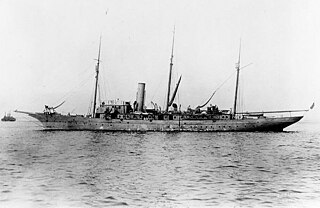
USS Harvard (SP-209) was a yacht leased by the U.S. Navy during World War I. She was outfitted as a patrol craft and assigned to patrol duty in the North Atlantic Ocean, protecting civilian ships from German submarines. In addition, she saved the lives of a number of survivors from ships that had been torpedoed. Post-war she was decommissioned and returned to her owner in her original civilian shipboard configuration.
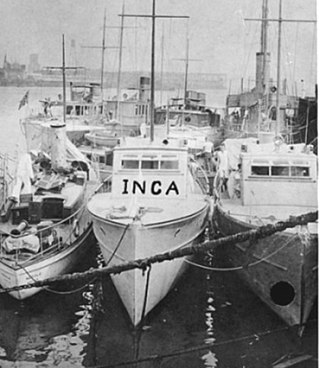
USS Inca (SP-1212) was a 62-foot-long motorboat leased by the U.S. Navy during World War I. She was outfitted as a patrol craft, but was additionally assigned other duties, such as rescue craft, seaplane tender, and dispatch boat. She served in the Boston, Massachusetts, and Hampton Roads, Virginia, waterways until war’s end when she was returned to her owner.
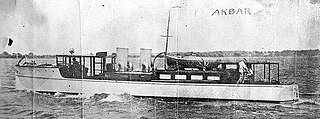
USS Akbar (SP-599) was first owned by George W. Childs Drexel of Philadelphia, a member of the city's Corinthian Yacht Club. The original name Akbar, apparently named for Mogul emperor Jalul-ud-Din Muhammed, known as "Akbar", was retained upon entry into naval service.
USS Little Aie (SP-60) was an armed yacht that served in the United States Navy as a patrol vessel from 1917 to 1919.

USS Rivalen (SP-63) was an armed motorboat that served in the United States Navy as a patrol vessel from 1917 to 1919.
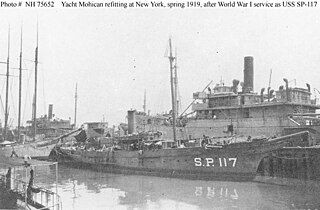
The third USS Mohican (SP-117), later USS SP-117, was an armed yacht that served in the United States Navy as a patrol vessel from 1917 to 1919.

The iron-hulled, single-screw steam yacht Utowana was completed in 1883 at Chester, Pennsylvania, by the Delaware River Iron Ship Building and Engine Works for Washington Everett Connor. On sale to Elias Cornelius Benedict the yacht's name was changed to Oneida (1887), then when Benedict bought a new yacht to be named Oneida and sale of the old yacht and conversion to a tow boat the name was changed to Adelante (1913). During Benedict's ownership Oneida was the covert site of an operation on President Grover Cleveland, a friend of Benedict's and frequent guest on the yacht, to remove a cancerous tumor in his mouth.
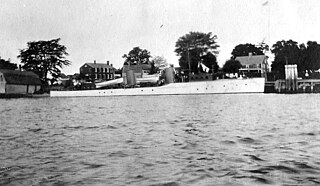
USS Cigarette (SP-1234) was a patrol vessel that served in the United States Navy from 1917 to 1919.

USS Get There (SP-579) was a United States Navy section patrol craft in commission from 1917 to 1919.
USS Fli-Hawk (SP-550) was a United States Navy patrol vessel in commission from 1917 to 1919.
USS Valeda (SP-592) was a United States Navy patrol vessel in commission from 1917 to 1919.

USS Satilla (SP-687) was a United States Navy patrol vessel in commission from 1917 to 1919.

The second USS Calumet (SP-723) was a United States Navy patrol vessel in commission from 1917 to 1919.
USS Itasca II (SP-803) was a United States Navy patrol vessel in commission from 1917 to 1918.
USS Bagheera (SP-963) was a United States Navy auxiliary schooner that served as a patrol vessel. She was in commission from 1917 to 1919.

USS Katrina (SP-1144) was a United States Navy patrol vessel in commission from 1917 to 1919.

USS Vitesse (SP-1192) was a United States Navy patrol vessel in commission from 1917 to 1918.
USS Wego (SP-1196), also spelled We-go and We Go, was a United States Navy patrol vessel in commission from 1917 to 1918.

USS Liberty III (SP-1229), sometimes written Liberty # 3, and also referred to during her naval career as Liberty and as Pilot Boat Liberty, No. 3, was a United States Navy patrol vessel in commission from 1917 to 1919. The Liberty was a pilot boat from 1896-1917. She was a replacement for the pilot boat D. J. Lawlor. After World War I, the Liberty returned to pilot service until 1934 when she was purchased as a yacht.

USS Louise No. 2 (SP-1230), sometimes written Louise # 2 and also referred to during her naval career as Louise and as Pilot Boat No. 2, was a United States Navy patrol vessel in commission from 1917 to 1919. The Louise, was a pilot boat from 1900 to 1917. She was a replacement for the pilot boat Columbia, that was washed ashore in 1898. After the World War I the Louise returned to pilot service until 1924 when she was purchased as a yacht. In 1924, the Boston pilot boat Pilot, took the place of the Louise.














